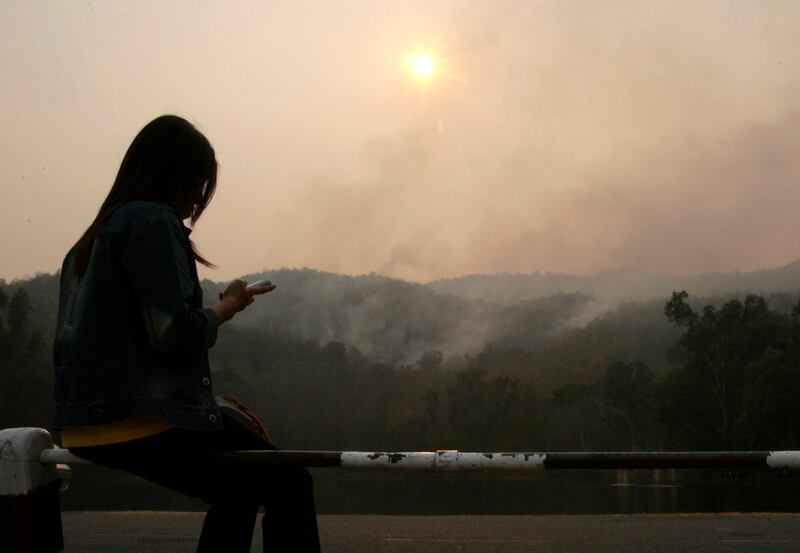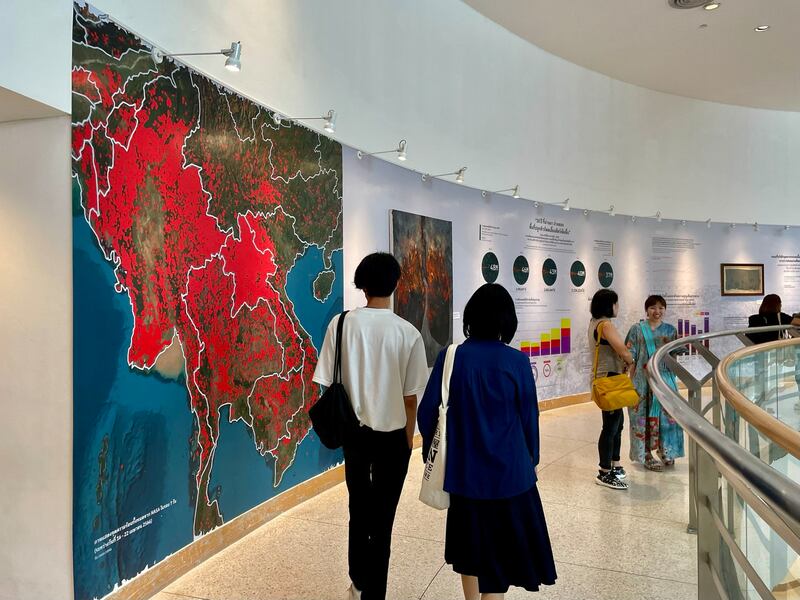Thailand’s clean-air campaigners are staging an exhibition in Bangkok to show how industrial-scale maize cultivation to produce animal feed is partly responsible for the toxic annual smog in the lower Mekong region.
“Hazibition,” an exhibition on haze pollution by environment group Greenpeace, started Tuesday at the Bangkok Art and Culture Center. It is an attempt to expose the root causes of smog that have become a persistent threat to the health of the population in the region, organizers said.
“We want to show the link between transboundary air pollution in the lower Mekong region and industrial-scale cultivation of maize by big corporations for animal feed,” Rattanasiri Kittikongnapang, a Greenpeace food and ecology campaigner, told Radio Free Asia.
“We have been suffering from haze pollution for more than 15 years without any clear action from the government to deal with the problem. So, we don’t want this year to be another year of suffering.”
In March and April, several provinces of northern Thailand, as well as border provinces of neighboring Laos and Myanmar, experienced the worst toxic haze pollution in years.
The northern Thai city of Chiang Mai topped the most polluted cities in the world, ranking for weeks. In some areas, it was 16 times worse than healthy levels. Over 2 million Thais experienced health issues due to haze, according to public health officials.
Activists and scientists have blamed out-of-control wildfires and agricultural waste burning due to intensified land use for commercial-scale farming of cash and plantation crops for the toxic haze, described as “the most severe in 20 years,” by Greenpeace.

Rattanasiri said they are still working on the data for this year’s smog to precisely ascertain how much air pollution can be attributed to maize cultivation alone.
However, in the past, maize cultivation for animal feed has been responsible for one-third of the transboundary haze, she said.
“We want people to shift their thinking, their mindset, and the narrative on this with this exhibition,” she said. “Those maize farmers are still poor and continue to suffer from smog. Meanwhile, the big corporations behind maize farming are getting richer.”
‘50 years in the making’
Thailand is among the world’s largest animal feed producers, as well as one of the largest pork and poultry producers globally. Maize is the primary ingredient, making up more than a third of the animal feed.
According to Greenpeace, 10.6 million rai (1.7 million hectares) - half the size of the Netherlands - was converted from forest to maize cultivation plantation for animal feed in the lower Mekong region between 2015 and 2019.
Thailand’s forest cover has decreased from 48 to 37 million rai (7.68 to 6.08 million hectares) in two decades, Greenpeace said, while the area under maize cultivation increased four times to 2.4 million rai (384,000 hectares).
“This haze problem is 50 years in the making, with the Thai government encouraging a policy that benefitted the meat industry solely to expand their business and influence in the sub-Mekong region,” Rattanasiri said. “That is the main cause of deforestation.”
“We want the government to take some tangible action, and we want people to pressure the government to go after the culprits - the big corporations responsible for maize cultivation,” she added.
Greenpeace said one of the first steps is for the government to amend the law to expand the liability of companies and operators in case of environmental and health hazards due to monocultures, such as haze from the use of fire in the plantations.

The Greenpeace exhibition, running through this week, shows a timeline of Thailand first launching industrial agriculture policy in 1961, which gave birth to contract farming, to the introduction of maize farming in 1987 as a key cash crop, which led to extensive forest encroachment, mainly to turn the land into contract farms, by 2000.
In the subsequent years, the government launched a policy promoting contract farming and brought the scheme to Laos and Myanmar with its zero-percent tax rate for maize imports. It also gave price guarantees and insurance for big companies in the maize business, as well as low-interest loans for maize farmers. Most of these policies continue today.
In 2022, Thailand imported maize for animal feed, totaling 13.2 billion baht (U.S. $382 million), the second largest import by value after electricity.
According to 2022 Greenpeace analysis, air pollution was behind approximately 29,000 deaths in Thailand, exceeding those from road accidents, drug use, and homicide combined.
Edited by Mike Firn.
